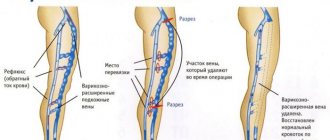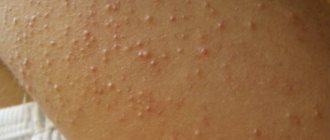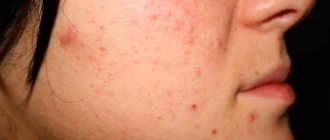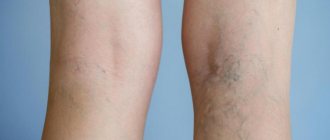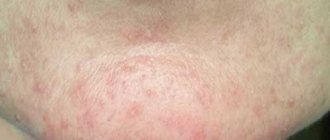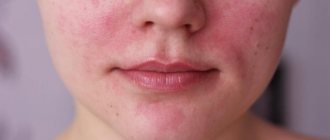Papillomas are benign neoplasms that can be localized on any part of the skin and mucous membranes. Caused by a viral infection. Papillomas on the face often need to be removed for aesthetic reasons; such formations have virtually no effect on a person’s health. For treatment in most cases, surgical methods are used - laser therapy, cryodestruction, electrocoagulation or surgical excision.
Papillomas on the face are not dangerous to health, they are mainly just an aesthetic problem
Causes of fibropapilloma formation
Doctors cannot name the exact cause of the development of the pathology. Scientists are inclined to believe that a person has a hereditary predisposition. There are many cases of papilloma occurring in people who are closely related. If there have been cases of fibropapillomas in the family, the person is considered prone to pathology. Pregnant women are susceptible to the development of fibroepithelial nevus, which indicates the influence of the body’s hormonal balance. Hormonal imbalance can trigger the occurrence of pathology. Neoplasms often appear in older people, which has led doctors to believe that the cause is related to skin aging.
Fibropapilloma of the gums and oral cavity can occur for the following reasons:
- Biting soft tissue regularly in the same place for a long time;
- A fragment of a tooth or denture that constantly injures the gums and soft tissues;
- Inflammation in the mouth - gingivitis, periodontitis, stomatitis and others.
Reasons for the development of the disease
Despite the rapidly developing medicine, at the moment it has not been possible to find out the exact cause that contributes to the formation of fibroids of the skin.
It is generally accepted that the hereditary factor plays the greatest role in the development of such tumors. It can also be assumed that hormonal balance in the human body also plays a role, since the active growth phase of fibroepithelial nevus occurs in pregnant women.
Due to the fact that fibropapillomas quite often occur in adulthood, it can be assumed that the impetus for the formation of benign tumors is skin aging .
Types of fibropapilloma
Skin fibropapilloma is of two types:
- Hard fibroma (dermatofibroma) has a dense elastic consistency. The tumor develops without causing discomfort. But when injured, unpleasant effects occur. The shape of papillomas can be dome-shaped or depressed. It is easy to determine by the characteristic dimple that appears when the edges of the nevus are compressed. Occurs on any part of the body. All ages are susceptible.
- The soft type (soft fibroma, acrochordon and papilloma) looks like a pouch of wrinkled skin. The color is usually similar to the skin tone or becomes brown. Diagnosed in older people and overweight people. It occurs in women under the mammary glands and on the surface of the mammary glands, in the armpits, neck and groin. Aggressive growth of a nevus indicates fibromatosis with hyperkeratosis. This formation can affect muscles. It often occurs on the feet and is accompanied by pain. The disease is caused by skin injury, infection or swelling on the tendons.
The following categories of people are susceptible to pathology:
- Women while pregnant;
- Fat people;
- Women aged 40 years and older;
- People diagnosed with diabetes.
Oral tumors are divided into the following types:
- The dense appearance is formed by coarse connective fibers with a small volume of nuclei in cells that are tightly adjacent. It affects part of the hard palate and gums.
- The soft type is formed by loose connective fibers with a high number of nuclei. The tumor forms on the tongue and cheeks.
- Papilloma from irritation is not a tumor. Represents the result of mechanical or chemical effects on the mucous membrane. This is the most common type found in medical practice. Formation of a regular round shape of pink color.
- Symmetrical fibropapillomas form on the gums and palate. The knot has a dense consistency and a bean shape. It is considered not true education.
- The lobulated appearance is a tuberous node that develops on the gum with frequent tissue trauma.
- Fibrous epulis has a dense tumor consistency that appears on the gum tissue. It grows slowly.
Signs of the disease
The pathology is similar in appearance to wen, moles and other skin nevi. Symptoms of fibropapilloma will help to distinguish the tumor:
- The nevus grows up to 3 cm;
- Increases in size slowly;
- Characterized by mobility;
- The skin lesion is pink in color and becomes brown or blue as it grows;
- The tumor has clear boundaries;
- When injured, it bleeds.
Papilloma of the mouth and gums is manifested by the following symptoms:
- The node protrudes above the mucosa due to the presence of a specific stalk;
- Develops without pain;
- Semicircle shape with pink color;
- The surface is smooth without the presence of outgrowths;
- It increases in size slowly;
- There may be an inflammatory process at the site of the neoplasm;
- Trauma to the nodule can cause the cells to degenerate into a malignant formation.
Consequences of skin pathology
Fibroma that affects the skin tissue is considered harmless. The cosmetic appearance of the tumor causes discomfort.
Fibroma can become dangerous if the nevus is damaged:
- Tumor bleeding;
- A foreign infection penetrates through an open wound, which can cause re-infection;
- Pain at the site of the fibroid;
- Healthy dermis and tumor lead to necrosis.
Fibropapilloma transforms into malignant cancer very rarely. This occurs when the nodule rapidly increases to the size of the palm of your hand. Soft fibromas are susceptible to transformation. At the same time, there are sometimes a large number of neoplasms on the body. A hormonal disorder can provoke a mutation.
Diagnosis of the disease
Skin neoplasms are identified by visual inspection. But to clarify the diagnosis, histology of the biological material is required. The sample is taken after surgical removal of the nevus. This allows us to exclude the possibility of lipoma, hygroma with atheroma. The skin formation is a nevoid node of connective tissue with a fiber structure. The tissue is filled with blood vessels, in which swelling and inflammation are possible.
Pathology of the oral cavity is often detected by a dentist during examination or treatment of a patient. If a suspicious lesion is detected, an extensive examination is required to clarify the diagnosis:
- An ultrasound examination of the mouth will reveal the depth of tissue damage.
- X-ray with radiovisiography will help to identify inflammatory processes inside the formation when using an orthopantomogram with a periodontogram.
- If the patient has dentures, consultation with an orthopedic dentist is recommended.
- After the tumor is removed, the biological sample is sent to the laboratory for biopsy and histology.
The formation of fibroids in the tongue requires excluding the possibility of tongue cancer. To do this, appropriate diagnosis is carried out, excluding other neoplasms.
Treatment of pathology
Fibropapilloma must be removed surgically. This is recommended for systematic injury to the affected area. The operation is performed under local anesthesia. Treatment with surgical intervention is carried out in the following ways:
- A standard medical scalpel is used.
- The electrocoagulation method allows for targeted excision of the tumor with high-frequency current.
- Radio wave removal makes it possible to affect other tumors as well.
- Laser treatment is considered the safest and most gentle method.
Treatment of fibropapilloma
An effective method of combating such tumors is surgery .
It is worth noting that it is worth resorting to removal of a nevus only if it is extremely poorly located and is often injured. Removal of fibropapilloma is carried out in a hospital under local anesthesia.
Let's take a look at the tumor removal methods:
- Excision with a scalpel.
- Electrocoagulation is the removal of a tumor using high-frequency electrical impulses.
- Radio wave technique for removing various third-party tumors.
- Using a laser.
Prevention of fibropapilloma of the skin and gums
There are no specific measures to prevent the formation of fibropapillomas. Doctors recommend that when fibroids are detected, injury and damage to the affected area should be eliminated. It is mechanical damage that causes complications. Localization of the tumor in an area subject to constant trauma is a reason for removal.
Relapse after removal is diagnosed in only 5% of all cases of the disease.
Papillomas are benign neoplasms that can be localized on the skin and mucous membranes of humans. They are provoked by the human papillomavirus, which actively invades its healthy cells.
Papilloma on the gums is a fairly common occurrence that can occur in both adults and children. At the same time, the virus is able to actively progress, so papillomas on the gums are often accompanied by the appearance of warts on the inner surface of the lips, tongue, cheeks and palate in the oral cavity. Photos of this condition can be seen on numerous forums of patients undergoing treatment.
Causes
As a rule, papilloma on the gums is not usually accompanied by the development of any unpleasant symptoms in humans. Moreover, often a growth is discovered by chance at a dentist’s appointment (if it is localized in a place in the oral cavity that is invisible to the person himself).
Insufficient oral hygiene can contribute to the appearance of papilloma in the mouth, which is why papillomavirus infection penetrates into it. In this state, after entering the body, HPV is capable of not manifesting itself at all for a long time, and is activated only after a sharp decrease in the patient’s immunity.
HPV is introduced to the mucous membrane of the gums in the following cases:
When a healthy person uses foreign objects and personal hygiene products contaminated with HPV. For example, this could be a toothbrush, dental floss, a toothpick, or even an ordinary towel. In this case, the likelihood of contracting a virus is as high as possible even with a single use of someone else’s object.- Poor handling of utensils intended for general use. This is especially common in public catering establishments.
- Kissing a person who is a carrier of HPV. In this case, the virus will penetrate directly onto the mucous membranes of a healthy person: gums and tongue. There he will further develop and express himself.
- Transmission of the virus to a child through birth when his mother is a carrier of HPV.
- Unprotected oral sex. In this case, the risk of condylomas and papillomas in the mouth and lips is very high.
- Using someone else's dentures or dental plates.
In addition, colds or infectious diseases, bad habits, stress, physical fatigue, and hormonal disorders can contribute to the activation of the virus in the body. All these factors invariably lead to a decrease in immunity, which can directly affect the manifestation of HPV in humans.
Why are they dangerous?
The main danger of papillomas is that they can transform into malignant neoplasms. This, in turn, threatens the development of the oncological process and all the ensuing consequences.
Of course, it cannot be said that the risk of papillomas transforming into cancer is very high, but most doctors argue that with strong growth of papillomas, the growth of pathogenic cells can become uncontrollable.
In addition, when papillomas are localized in the oral cavity, a person constantly feels discomfort.
This is due to the presence of many nerve endings in the mouth, which cause burning and pain to the patient.
According to statistics, today 15% of men and 30% of women suffer from papillomas on the gums.
It is important to know that when the papilloma is located on the gum, the likelihood of mechanical injury is very high. This can happen while eating or even while talking. Moreover, a humid environment with colonies of microbes will constantly prevent the healing of the wound, facilitating the introduction of infection into it.
When you detect the first manifestations of papillomas on the gums, it is important to immediately consult a doctor. If necessary, he can prescribe the patient treatment with salicylic acid or other effective drugs.
When to see a doctor
Not in all cases, the appearance of papilloma on the face requires visiting a doctor and active treatment. If the formation does not cause discomfort and is not injured, you can be calm.
If the papilloma is often injured or causes discomfort, you need to consult a dermatologist. The doctor will carefully examine the tumor and, if necessary, prescribe additional tests:
- Dermatoscopy. This is a research method using a special instrument - a dermatoscope, which allows you to examine skin formations under 10x magnification.
- Polymerase chain reaction (PCR). PCR is used to identify the pathogen (HPV type - oncogenic or not). The material for the study is a scraping from the affected area of skin.
Removal of papilloma on the gums and basic treatment methods
If the doctor determines that the neoplasm on the mucous surface of the gums is benign, then traditional drug therapy will be selected for the person. First of all, in this condition the patient needs to undergo complete sanitation of the oral cavity. It involves the elimination of plaque, stones and caries.
Next, the patient is prescribed immunomodulatory drugs (Interferon).
To more quickly suppress HPV in the body, the patient must be prescribed antiviral drugs, as well as vitamin therapy. As an additional treatment, a person is advised to carefully maintain oral hygiene and diet.
What do papillomas look like?
Papillomas
Under certain conditions, the virus begins to manifest itself by the appearance of formations on the skin and mucous membranes. Papillomas and warts on the skin usually do not cause trouble to a person. But if they are localized in the mouth, unwanted sensations appear.
Papilloma is a benign neoplasm that rises above the surface of the skin. It may take the form of a papilla (polyp) on a stalk, expanding from above, or a cone. Inside the papilloma there is a stroma (vascular base), on which epithelial cells grow.
You can even diagnose the disease yourself by the appearance of the formations.
Mostly single papillary papillomas are found. But sometimes they are connected to each other by tissue and grow. This phenomenon is called papillomatosis.
The color of the growth can be either uniform with the color of the skin or darker - from pink to brown. The size of the formations ranges from the head of a match to a human fist.
Dark colored papillomas
Papillomas appear in adults and children on the neck, under the breasts, in the armpits, on the oral mucosa and genitals. Papillomatosis of internal organs is rare.
What it is
Papilloma is a benign tumor-like formation that appears on the skin in the form of papillae. The formations may enlarge and grow, taking on the appearance of cauliflower or cockscomb.
What does papilloma look like (seen in the photo):
- The color in most cases is closer to flesh-colored and can range from white to brown.
- The average size is 0.2–10 mm; less commonly, formations can grow up to 2–3 cm.
- The formation is soft and dense to the touch; palpation is not accompanied by painful sensations.
- Papilloma can be localized in any part of the body. On the face, formations most often appear around the eyes, less often on the chin, cheek, and around the nose.
Types of papillomas
There are several types of papillomas in the mouth:
- Epithelial hyperplasia - small formations in the form of papillae, most often formed on the sides of the tongue;
Epithelial hyperplasia Simple (vulgar) papilloma appears on the palate and has the shape of a flattened lump;
Vulgar papilloma Growths on the gums are most often presented in the form of flat papilloma;
Flat papillomas Thread-like papillomas have a thin base, which often causes bleeding and inflammation if they are injured. Found on the frenulum of the tongue;
Thread-like papillomas on the tongue Genital warts have a cone shape, connect to each other and form large lesions.
Pointed papillomas
Important! Delayed diagnosis threatens the growth of papillomatous nodes on the mucous membranes of the respiratory tract.
Papillomas on the tongue and cheek can have different shapes. Polyps on the cheek are small, soft bumps and do not cause pain. Growths on the tongue are subject to irritation and microtrauma, which can cause bleeding.
Papillomas on the gums
Papillomas on the tonsils are often confused with laryngitis or purulent tonsillitis. Due to the growths, there may be swelling of the airways and vocal cords, which causes difficulty breathing. Unpleasant sensations accompany the process of absorbing food, even liquid food. Sometimes a person experiences the sensation of a foreign body in the throat.
The appearance of papillomas on the larynx may be accompanied by changes in voice and breathing problems. When eating solid food, the mucous membrane with growths may bleed. A red throat in a child may indicate the presence of growths. Laryngeal papillomatosis in children is the cause of bronchitis.
The appearance of pathological formations in the form of a lump or polyp on the gum (growths on the gums) is dangerous because the mucous membrane will be injured by a toothbrush or dentures. Ultimately, this will lead to inflammation and infection of non-healing ulcers.
Sometimes growths on the gums are called fibropapilloma. Despite the similarity in definitions, this neoplasm has nothing to do with the human papillomavirus.
Fibropapillomas in the mouth
In older people, the appearance of formations on the tongue is sometimes associated with the use of dentures.
How to get rid of papillomas on the face
If there are indications, it is recommended to carry out surgical treatment - remove formations using a laser, liquid nitrogen, or an electrocoagulator. Treatment at home is less effective and is associated with a number of complications (a scar on the skin after removal, bleeding, suppuration), and therefore is used much less frequently.
Indications for treatment
Not all formations on the face need to be removed. What are the indications for removal:
- frequent injury;
- psychological and aesthetic discomfort;
- presence of complications, suspicion of malignancy.
The decision to remove papilloma is made individually. This largely depends on the wishes of the patient; in most cases, such formations do not pose a health hazard.
Papillomas on the face: treatment at home
At home, you can use folk remedies. This treatment is available, but has a number of disadvantages:
- after removal, a noticeable scar may remain on the face;
- the use of aggressive agents can lead to skin burns;
- mild folk remedies rarely lead to the desired effect;
- To achieve an effect, long-term use of folk remedies is often required (2 months or more), which still does not guarantee results.
To treat papillomas, you can use folk remedies of mild and more aggressive action. Products based on potatoes and aloe are gentle, while garlic, lemon, apple cider vinegar, and salicylic acid are more aggressive. The skin on your face is delicate, so all products need to be applied precisely and very carefully.
| Means | Recipe how to use |
| Apple vinegar | Apple cider vinegar must be diluted with water in a 1:1 ratio. To apply to the skin, use a cotton swab (spot application), do not rinse. You need to repeat the procedure once a day for 2 weeks. If any side effects occur (pain, redness of the skin, burning), you should stop treatment. |
| Garlic | To prepare the product you will need 1 clove of garlic. The garlic needs to be crushed and the resulting pulp applied to the skin. Place an adhesive plaster on top and leave for 4 hours. The procedure must be repeated once a day for 2 weeks. |
| Lemon juice | To prepare, you will need to squeeze the juice from the lemon. Lemon juice should be applied to the skin pointwise. Repeat the procedure 3 times a day for 21 days. |
| Aloe juice or leaf compress | Soak a cotton pad in aloe juice, apply it to the affected area of skin, and cover the top with an adhesive bandage. You can also use a whole aloe leaf and apply its pulp to the skin. The compress is left overnight. The procedure must be repeated once a day for 3–4 weeks. |
| Potato compress | Grate the potatoes on a fine grater, apply the resulting pulp to the skin, apply a gauze bandage on top and seal with an adhesive plaster. This compress is left for 8 hours (can be overnight). Repeat the procedure every day for 2-3 months. |
Causes of papillomas in the mouth
The main reason for the appearance of growths in the mouth is the presence of the human papilloma virus in the body. It is easy to become infected with it: the virus is transmitted through household contacts and through personal contacts (touching, unprotected sex).
The main ways of infection with the virus:
- Failure to comply with personal hygiene rules, using other people's toothbrushes and towels;
- The household method involves poor disinfection of objects and utensils shared with an infected person;
- Personal contact with a virus carrier (kissing, oral sex, sexual intercourse);
- Infection of the virus in a newborn occurs during passage through the birth canal from a mother who is a carrier of HPV.
The incubation period of the disease can last several years. HPV can only be detected through testing.
There are a number of factors that influence the activation of the virus and the appearance of symptoms:
Transmission routes
Human papillomavirus is transmitted:
- During sexual intercourse, including anal, oral-genital.
- By everyday means. The microorganism can exist on contaminated personal belongings, personal hygiene items, and towels. It easily penetrates through scratches and abrasions on the skin.
- During the birth process from mother to child.
Self-infection is possible if the virus is transferred from one part of the body to another, which usually occurs during shaving and hair removal.
The incubation period (the period from HPV entry into the body until signs of pathology appear) ranges from several weeks to several years.
Papillomas on the body most often appear during illness, pregnancy, alcohol abuse, psycho-emotional stress, hypothermia, accompanied by a decrease in immune defense. The incidence of these formations in men and women is the same.
Which doctor should I contact?
If ulcers, tumors or growths appear in the oral cavity, you should consult a dentist, ENT specialist or dermatologist. This depends on the location of the tumor.
Attention! Only a specialist can determine the correct treatment method! Most often, an integrated approach is required - removal of growths, use of antiviral drugs and immunomodulators.
To accurately distinguish papillomas from other neoplasms, a specialist will conduct an examination and prescribe some tests. A blood test for antibodies will help confirm the presence of human papillomavirus.
The doctor will advise the woman to visit a gynecologist for smear tests. Before starting treatment, a cytological examination of papillomas and consultation with an oncologist may be required to eliminate the risk of developing cancer.
After confirmation of the diagnosis, a consultation with an immunologist or virologist will be required to determine a treatment regimen.
Papillomas on the face: causes
The main reason why papillomas occur is papillomavirus infection (human papillomavirus, HPV). There are many types of papillomaviruses, some representatives of this group may have oncogenic properties. HPV infection occurs through contact; the entry points are places where the integrity of the skin is damaged (microtraumas, scratches, abrasions). In addition, self-infection is possible during shaving or hair removal.
Typically, HPV infection occurs against the background of decreased immunity. Immune function can be affected by many conditions:
- HIV infection;
- taking certain medications (glucocorticoids, cytostatics);
- chronic kidney diseases (glomerulonephritis, renal failure);
- poor nutrition (deficiency of vitamins and proteins in the diet);
- endocrine disorders: diabetes mellitus, hypothyroidism, menopause in women;
- chronic intoxication with chemicals;
- open and invasive surgeries, severe injuries.
Decreased immunity for any of these reasons increases the risk of HPV infection.
The cause of the appearance of a growth on the face may be prolonged trauma to the skin. In addition, papillomas can be congenital, in which case genetic abnormalities are the cause.
Ways to get rid of papillomas in the mouth
There is no cure for HPV. A person infected with it remains a carrier for life. However, it is possible to remove papillomas.
The main methods of treating papillomas in the mouth are medication and removal of tumors. In most cases, complex therapy is used. Removing condylomas, papillomas and other formations will help get rid of unpleasant sensations. The use of medications is aimed at combating the cause of the formation of growths.
Treatment with medications
Amiksin
First of all, the oral cavity is sanitized (treatment). For this purpose, anti-inflammatory drugs and antiseptics are used to treat caries and other dental diseases. After sanitation, the lesions are treated with topical antiviral drugs (ointments, gels).
To suppress the activity of the virus, antiviral therapy (interferons, Amiksin, Viferon) and the use of immunomodulators (Polyoxidonium, Likopid, Immunomax) are used.
It happens that papillomas are accompanied by a secondary infection. This can occur due to inflammation due to injury to the oral mucosa. In such cases, the doctor will recommend antibacterial therapy. To support the body, vitamins are prescribed.
Methods for removing papillomas in the mouth
Children and adults can remove papillomas and other manifestations of HPV in several ways:
Electrocoagulation of papillomas in the mouth
Laser removal. The method involves thinning tumors by exposure to laser beams. This method is good because only the affected area of the mucous membrane is exposed;
- Excision of papillomas with radio waves allows a more detailed study of the morphology and structure of neoplasms after their removal. This is necessary to exclude the possibility of the formation of cancer cells;
- The method of removing tumors in the mouth with liquid nitrogen (cryodestruction) is not recommended due to the high risk of developing a malignant tumor after using chemical compounds;
- Surgical removal of growths is rarely used, only when large nodes form.
- Soak a bandage or cotton pad with castor oil and apply to the affected areas;
- Make an alcohol tincture from walnut leaves and lubricate the new growths with it;
- Apply garlic to the growths.
Remember! You cannot tear off or cut off papillomas yourself!
Video: removal of papillomas of the lower lip mucosa
Methods of traditional medicine
There are several ways to treat papillomas at home using traditional methods. But they should only be used with the permission of the attending physician, because for some types of HPV, traditional medicine is contraindicated.
The most common methods:
Castor oil
Lubricate papillomas with the white of a raw egg. This method has an effect at the initial stage of the disease;
Despite their popularity, these methods are questionable. Raw eggs are dangerous for salmonellosis. Tinctures with alcohol and garlic can burn the already damaged mucous membrane. And when treating papillomas in the mouth of children, it is better not to use such methods at all.
Video about the treatment of papillomas in the mouth
Treatment methods for papillomas on the face
Growths can be disturbing not only because of the aesthetic issue, but they also need to be removed if there is a possibility of them turning into malignant lesions. The treatment method is always recommended by the doctor; in some cases, removal of papillomas can be performed at home, while other methods are possible only on an outpatient basis.
The most common methods for removing warts are:
- cauterization with liquid nitrogen;
- laser removal.
The most commonly used method of treating growths is to remove them by exposing them to cold nitrogen, as a result of which the papillomas are destroyed. This method can be used after tests if the tumor is benign. This procedure lasts up to 20 minutes and is suitable for removing growths on the face, even in the eyelid area. Taking care of your face afterwards is also easy:
- after the affected area has been frozen, it is recommended to wipe it with boric alcohol or manganese solution for a week;
- After a few days, the growth disappears, and renewed skin appears in its place.
It is very important that the cauterization process is carried out correctly; if the effect is weak, the growth will not disappear, but if it is strong, it can touch healthy areas of the skin and leave a scar on the face.
Treatment of papillomas with laser
Laser removal of warts is the safest way to get rid of them. The growth is removed with a laser beam within a few minutes; the beam itself, in turn, has an antiseptic effect. After the laser procedure, papilloma will no longer appear in this place. In addition, laser treatment can be applied to papillomas on the upper and lower eyelids , without worrying that the beam will enter the eye and negatively affect vision.
After the growth is removed with a laser, small dimples may form in its place, which disappear over time. However, while they are present, the healing area should not be exposed to sunlight, otherwise spots will remain.
Other treatments:
- electrocoagulation - an electric current is applied to the papilloma, which dries it out, then it disappears. For 10 days, the treatment site should be treated with a calendula solution. If the treatment is weak, growths in this place may appear again. The advantage of the method is cost-effectiveness;
- surgical intervention is practiced only when the size of the growth exceeds a centimeter, and the growth itself is covered with cancer cells. The operation itself lasts about 20 minutes and may affect some healthy tissue. The disadvantage of this method of treatment is the scars;
- chemical treatment of papillomas. The growth is dissolved with an acid based on organic and inorganic acids. The procedure is quite long: to completely dissolve the growth it must be carried out after 2-3 days.
How to treat papillomas at home
To get rid of papilloma on the face and other parts of the body on your own, you can ask your doctor which method he can recommend in a particular case. infusions, compresses and homemade ointments will help you cope with unwanted growths . Here are the recipes for some of them:
- herbal infusion to strengthen the immune system in the treatment of papillomas - take a tablespoon of medicines such as horsetail, lemon balm, dandelion root, plantain and nettle, chop them and combine. Pour a few tablespoons of this mixture into a liter of boiling water and boil for 10 minutes over heat. We infuse the decoction for 4 hours and can take 50 ml before meals three times a day for a week;
- garlic ointment to remove papilloma – take 1 teaspoon of chopped garlic and combine with 2 tablespoons of any cream that suits your skin type. Apply this ointment to the wart for several hours, and then rinse with warm water;
- tincture based on dandelions. This infusion will help get rid of papillomas on the face as quickly as possible. Take the dandelion heads and press them tightly into a glass bowl, then fill them with a bottle of triple cologne. Leave the mixture for about 20 days, and then lubricate the affected areas of the skin with it up to 5 times a day until the growths disappear;
- compress based on Kalanchoe leaves. Cut fresh leaves and apply them to the papilloma, securing with adhesive tape. You need to keep the compress overnight. This product will help get rid of growths in less than 2 weeks.
It is worth remembering that home treatment has a number of risks and disadvantages. A papilloma removed on its own will not disappear quickly , and there is no guarantee that it will not appear again.
Also remember that outwardly benign and malignant formations do not differ from each other, therefore, without consulting a doctor, prescribing one or another treatment for yourself is fraught with dangerous consequences.
Are papillomas in the mouth dangerous?
Most often, the formation of growths in the mouth is not life-threatening. The main danger is that papillomas in the mouth are often exposed to mechanical stress (for example, brushing teeth) and temperature changes (cold, hot food). This can cause injury to the oral cavity and the development of inflammatory processes.
But there are a number of signs that should alert a person:
Such symptoms may indicate the degeneration of formations into a malignant tumor. The fact is that the development of papillomatosis in the mouth is associated with infection with certain types of HPV - 2, 6, 11, 18, 30.
Possible complication
HPV type 18 is one of the most dangerous strains of the virus. It has a high degree of oncogenicity. Formations that arise as a result of infection with this type of virus most often degenerate into cancer.
Attention! If any neoplasm appears in the mouth, you should see a specialist and do not self-medicate!
Disease prevention
There are no preventive standards for the formation of fibropapillomas. And already formed tumors should be carefully protected from injury and damage. If the location of the fibroma is extremely unfortunate, then it is recommended to remove it.
After removal of all tumors, relapse occurs extremely rarely, only in 5% of all cases. And as we have already said, fibropapillomas are not prone to degeneration into malignant tumors, therefore, apart from their aesthetic appearance, they do not cause any trouble.
Add a comment
